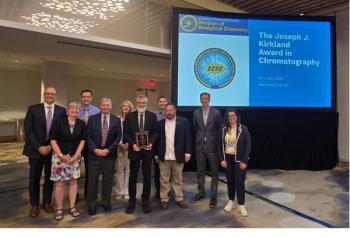
HPLC Used to Quantify Tomato Polyphenols
Scientists from Gansu Agricultural University recently used high-performance liquid chromatography (HPLC) to quantify 16 polyphenols in tomato fruits.
Scientists from Gansu Agricultural University in Lanzhou, China used high-performance liquid chromatography (HPLC) to quantify 16 polyphenols in tomatoes. Their findings were published in the Journal of Chromatography A (1).
Polyphenols are various kinds of compounds with benzene rings and multiple hydroxyl groups, which widely exist in secondary plant metabolites. They exist in leaves, fruits, seed coats, and fruit shells, playing vital roles in the formation of appearance quality, nutrition, and flavor quality of fruits and vegetables. They can also affect plant growth and development, signal transduction, and gene-induced expression. Polyphenols include flavonoids, phenolic acids, anthocyanins and tannins, with procyanidins being thought of as “the seventh type of nutrients.” Recently, natural polyphenols obtained from plants were found to have significantly positive effects on antioxidation, bacteriostasis, antiviral, and anti-inflammatory diseases. They can also effectively present chronic diseases like hyperlipidemia and reduce cancer risk, among other benefits.
Polyphenols are the main type of bioactive compound in tomatoes. Various types of polyphenols exist in tomato fruit, with the main components including chlorogenic acid, caffeic acid, ferulic acid, rutin, naringenin, and quercetin. Their polyphenolic composition and content depend on tomato cultivars, processing patterns, and detecting techniques.
For this study, the scientists examined a new method for evaluating and quantifying 16 polyphenol compounds from tomato fruits using HPLC. To establish the method for simultaneous polyphenol quantification, the scientists designed and screened the chromatographic condition of mobile phases, UV absorption wavelength, flow rates, column temperatures, and injection volumes. The method’s applicability was also proven by determining polyphenols in nine cultivars of tomatoes.
The polyphenols were separated in under 60 minutes using a Waters Symmetry C18 column (250 × 4.6 mm i.d, 5 µm particle sizes) with a gradient system of ultrapure water (1% acetic acid) and 100% methanol, a temperature of 30 °C, an injection volume of 10 μL and a flow rate of 1.1 mL/min, respectively. The evaluation method’s analytical characteristics also provided sufficient sensitivity for all tomato polyphenolic compounds with a normal range of 0.1–20 μg·mL−1 (R2 ≥ 0.999) with 0.069–0.365 μg·mL−1 LOD, and 0.171–1.106 μg·mL−1 LOQ, with good system suitability (< 2% RSD of retention time, peak area, and tailing factor, 6,000–1,336,000 N, and > 1.5 peak resolution), < 10% RSD of precision, stability, repeatability, and robustness, and 99.2–105.0% of recovery. When applied to the tomato cultivars, the main polyphenol components found were were rutin, quercetin, gallic acid, chlorogenic acid, 2,5-dihydroxy benzoic acid, caffeic acid and benzoic acid in tomato fruits.
Overall, 16 polyphenols were studied in this experiment, including 4 kinds of flavonoids and 12 kinds of phenolic acids. The 4 kinds of flavonoids were rutin, quercetin, naringenin, kaempferol, and 12 phenolic acids were 3,4-dihydroxybenzoic acid, p-hydroxybenzoic acid, chlorogenic acid, gallic acid, p-coumaric acid, ferulic acid, trans-cinnamic acid, 2,5-dihydroxy benzoic acid, caffeic acid, cynarin, benzoic acid, and sinapic acid. With these findings, this method could provide reliable scientific support for further studies about secondary metabolites in tomato fruit.
Reference
(1) Xiao, X.; Liu, F.; Sun, M.; Tang, Z.; et al. Development of a High-Performance Liquid Chromatography Method for Simultaneous Quantification of Sixteen Polyphenols and Application to Tomato. J. Chromatogr. A 2024, 1733, 465254. DOI:
Newsletter
Join the global community of analytical scientists who trust LCGC for insights on the latest techniques, trends, and expert solutions in chromatography.





